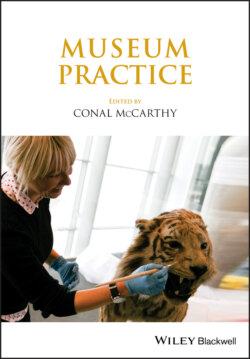Читать книгу Museum Practice - Группа авторов - Страница 52
“Arm’s-length” museums
ОглавлениеArm’s-length museums are so called because they operate at some distance from the “head,” the central governing agency. This “arm’s length” may be longer or shorter, but in all cases is intended to encourage greater financial independence and freedom from political or corporate control, even though the “head” organization retains ultimate authority. The “arm’s length” may be established in various ways:
Boards of trustees for arm’s-length institutions may be given real authority and responsibility as governing boards, sometimes within certain limits. The governing authority – government department, university administration, or corporation – is usually represented on the board, with the rest of its members appointed to include collectors, concerned interest groups, or the general public. Although the collection and buildings are still publicly owned, the board is said to hold the collections in a public trust.
Budgets are usually based on annual grants (as distinguished from departmental budget allocations), with the understanding that these grants will not meet all costs, so that the board of trustees has responsibility for raising the balance, through private donations, self-generated revenues, and grants from other levels or branches of government.
Museums are enfranchised to benefit directly from their self-generated revenues – admission fees, retail, rentals, food services, or other sources of funding.
Staff may remain civil servants, or may be employed directly by the museum, often granted status and benefits equivalent to or better than civil service conditions of employment.
Arm’s-length institutions are usually more successful than government line department museums at attracting donations, developing membership programs, recruiting Friends’ organizations and enlisting volunteer activities.
Not all of these features are found in every arm’s-length institution. During the 1980s in the United Kingdom Margaret Thatcher’s government gave a great impetus in this direction to Britain’s national museums, with most of the emphasis on the individual institution’s responsibility for its own fund-raising and ability to profit from its own enterprise. In Paris the Louvre is now solidly established as an arm’s-length institution, having developed a series of grands projets and currently participating, along with eight other French national institutions, in France Museums, a consortium that is providing long-term loans and short-term exhibitions from their collections to the Louvre Abu Dhabi on Saadiyat Island, in exchange for substantial funds that are being used primarily for conservation of France’s national collections. In 2003 the Prado in Madrid became an arm’s-length institution, still strongly linked to government but with its own board and a long-range goal of reducing its reliance on government funding from 80 to 50 percent of its budget. Several years ago we undertook a study for Hong Kong’s Leisure and Cultural Services Department that considered the extent to which an arm’s-length model might benefit government- operated museums there.
